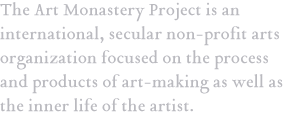Linguistic Monasticism
How important is the distinction between female and male monastics historically? Linguistically? In terms of a contemporary movement of secular monastics?
Historically, no profession is as defined by splitting men from women as monasticism. In fact, it’s written into the DNA—the monastic rules and vows—of most orders that for the process to succeed, monks (or bhikkhus) have to be kept away from nuns (or bhikkhunis) and nuns have to be kept away from monks. If your goal is to maintain a steady community whose purpose is to seek God or follow the dharma and not to continuously lose members who want to fall in love (and get jealous, and get married, and have babies, and therefore have to get a job, etc.) this is a perfectly reasonable mandate.
So what is monasticism without that gender divide? What is monasticism without celibacy?
At the Art Monastery, our lives are mostly not (intentionally) celibate, sometimes polyamorous, and almost always with no separation between the lives of men and women. This has more to do with who happened to show up and create this community than any decision or rule that it must be so. So how can we justify these choices in terms of the perpetually intentional life of a monastic? How does a monogamous or polyamorous love life fit into our holy of holies, our prayer — the making of art?
These are intriquing questions, but for now I’ll focus on the linguistic end of that discussion. It’s a topic I’ve addressed before.
Do secular monastics gain by holding on to the monk/nun distinction, or is the distinction no longer serving us? Is this distinction as emphasized in other languages as it is in English? Has it always been the case that there is one word for male monastics, and a different word for means female monastics?
An article by Natalie Wendt in Tikkun Daily Blog got me thinking more about this. “Nuns, Invisibility, and the Question of Buddhist Activism“:
Oh, but maybe the term “monk” was meant include “nun” too… The term “monks” implies the subset of “nuns,” just like “man” includes the subset of women, right?
Except we know it doesn’t. A child of the ’80s, I find use of the word “man” to mean “human” distractingly unfamiliar. Growing up with a feminist mom, it just seems outdated and bizarre to use gender-specific terms to refer to the whole of humanity. I also benefited from feminist activism within my Western Buddhist community, which had corrected a lot of sexist language before I ever heard it. In the thirteen years I’ve been saying translations of Tibetan prayers, I’ve been saying phrases like “monastics” or “monks and nuns” instead of just “monks.” In my early twenties I trained at a Western Buddhist Abbey that uses the term “monastics” instead of words that emphasize gender. This abbey was founded and is run by a Western bhikshuni (fully ordained Buddhist nun) who has been confronting sexism within the Buddhist community for decades.
In language and praxis, the history of monasticism is deeply informed by sexism. Thus I appreciate the spirit of wanting to level the field, either by fastidiously saying “monks & nuns” or “brothers & sisters” or “fratres et sorores” or “monastics.” But is it counter-productive to do so? Pragmatically, mightn’t a “monk” be like a “doctor” — a gender neutral profession?
From the classical Greek word “monos”—alone—comes the late Greek word for a monastic person, “monakhos,” which then made its way to various Romance, Germanic, Slavik and Finno-Ugric languages.
“Nun” comes from the same root as the Italian word nonna — grandmother or old woman.
Below I take a rather unscientific look at languages that appear to have adoped the late greek “monakhos”. Languages in bold use it for monastics of both genders. Languages in italics use the monk/nun split. Others have a different word for nun.
- Albanian: murg, murgeshë
- Belarusian: манах, манашка (“Manach”, “Manashka”)
- Bulgarian: монах, монахиня (“Monach”, “Monachinya”)
- Catalan: monjo, monja
- Filipino: monghe, mongha
- French: moine, moniale
- Greek: μοναχός, μοναχή (monachós, monachí̱)
- Italian: monaco, monaca
- Latvian: mūks, mūķene
- Macedonian: монах, монахиња
- Russian: монах, монахиня (monah, monahinya)
- Serbian: монах, монахиња
- Slovak: mních, mníška
- Spanish: monje, monja
- English: monk, nun
- Africaans: Monnik, non
- Estonina: munk, nunn
- Finnish: munkki, nunna
- German: Mönch, Nonne
- Icelandic: munkur, nunna
- Norwegian: munk, nonne
- Swedish: munk, nunna
- Danish: munk, nonne
- Dutch: monnik, non
- Slovenian: menih, nuna
- Polish: mnich, zakonnica
- Portuguese: monge, freira
- Czech: mnich, jeptiška
- Welsh: mynach, leian
- Irish: manach, bean rialta
- Galician: monxe, freira
Is it a mere fluke that the more germanic languages held on to the monk/nun split? Most romance languages decline nouns indicating professions (doctor, writer, etc.) for gender, but so does German, I think…
Would another word be less historically or politically charged? How about:
- votary – “one consecrated by a vow,” from L. votum
- monastics – Wendt’s suggestion
I think the solution is a pragmatic one. That is: if we want monks to be gender neutral profession, we should use it as a gender neutral profession.
Leave a Reply
You must be logged in to post a comment.




